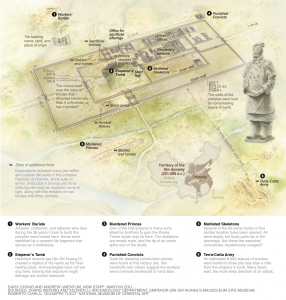11 Intro to the Terracotta Warriors
What are the Terracotta Warriors?
The tomb of the First Emperor was discovered in 1974 by some farmers who were digging. These farmers discovered ancient artifacts from Qin dynasty (221-206 BCE) China, more specifically the tomb of the First Emperor. Archaeologists have now dug up some of the pits, but there is excavation has stopped due to the exposure of air and light damaging the warriors.[1] In the vicinity of the tomb (which has not yet been opened), two bronze chariot models with a charioteer and four horses each, eight thousand uniquely decorated soldier figures, figures of other professions, weapons, and other artifacts were discovered. Each soldier was crafted so no facial features were the same, the original coloring of the soldiers were to distinguish between their rank. Sadly, the color faded from these soldiers upon exposure to air when they were excavated.
Historians believe that over 720,000 laborers worked on the mausoleum for thirty-seven years.[2] Qin didn’t want anyone to know where the tomb was, so he had the workers buried alive. [3] It is not yet clear where the idea for this tomb came from, but “…experts have worked out a theory: Inspiration for the terra-cotta army may have come from foreign artists. Traveling from Hellenized areas of Western Asia and arriving in China 1,500 years before Marco Polo, they could have trained the local craftsmen who furnished the emperor’s tomb with statuary.”[4]

Bibliography
Nickel, Lukas. “The First Emperor and Sculpture in China.” Bulletin of the School of Oriental & African Studies 76, no. 3 (20131001): 413–47.
Sun, Yan. “Mausoleum of Qin Shi Huangdi.” In Berkshire Encyclopedia of China: Modern and Historic Views of the World’s Newest and Oldest Global Power, edited by Linsun Cheng. Berkshire Publishing Group, 2009, via Credo Reference.
Williams, A.R. “Discoveries May Rewrite History of China’s Terra-Cotta Warriors.” National Geographic, October 12, 2016. https://www.nationalgeographic.com/history/article/china-first-emperor-terra-cotta-warriors-tomb.
- A.R. Williams, “Discoveries May Rewrite History of China’s Terra-Cotta Warriors,” National Geographic (website), October 12, 2016, https://www.nationalgeographic.com/history/article/china-first-emperor-terra-cotta-warriors-tomb. ↵
- Yan Sun, “Mausoleum of Qin Shi Huangdi," In Berkshire Encyclopedia of China: Modern and Historic Views of the World’s Newest and Oldest Global Power, edited by Linsun Cheng, via Credo Reference, 2009. ↵
- Williams, “Discoveries May Rewrite History of China's Terra-Cotta Warriors.” ↵
- Williams, “Discoveries May Rewrite History of China's Terra-Cotta Warriors,” referring to the following paper by Lukas Nickel, “The First Emperor and Sculpture in China.,” Bulletin of the School of Oriental & African Studies 76, no. 3 (20131001): 413-447. ↵
